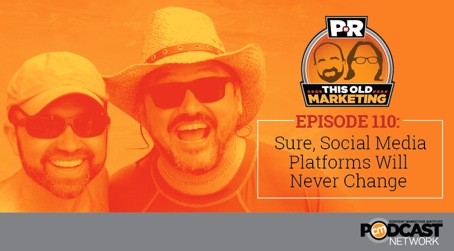PNR: This Old Marketing with Joe Pulizzi and Robert Rose can be found on both iTunes and Stitcher.
In this pre-Christmas episode, Robert and I discuss the meteoric growth of T Brand Studio, The New York Times’ content studio, and predict what will happen to Madison Avenue agencies if they ignore it. Next, we ponder Shafqat Islam’s 2016 content marketing predictions, and point out where our opinions align with and diverge from his prognostications. Finally, we question the wisdom of Basecamp moving its blog to Medium. They’re doing this under the premise that Medium won’t try to monetize the Basecamp blog without its permission. We think Basecamp executives may end up with coal in their Christmas stockings. Rants and raves include the renaissance in scripted TV content and a review of Joe’s 2016 predictions. We wrap up the show with a #ThisOldMarketing example from Rudolph the Red-Nosed Reindeer.
This week’s show
(Recorded live December 20, 2015; Length: 1:01:41)
Download this week’s PNR This Old Marketing podcast.
If you enjoy our PNR podcasts, we would love if you would rate it, or post a review, on iTunes.
1. Content marketing in the news
- Industrial strength branded content (5:20): Last year, The New York Times set up an entire division devoted to producing and commercializing content for its advertisers, T Brand Studio. In less than 12 months, it has a staff of 50 people and sales in the neighborhood of $30-40 million – 15-20% of the $200 million the NYT will make this year in digital advertising. Robert warns what will happen to Madison Avenue agencies if they continue to ignore the growing threat posed by big media content studios. He and I agree there’s a lot of risk in simply outsourcing content creation and distribution to an ad agency or content studio, and we explain why.
- 2016 content marketing predictions (17:45): In 2015, content marketing peaked, according to a new article by Shafqat Islam, the CEO of NewsCred. 2016 will be a challenging year, as marketers struggle to justify their investments in it. But those who persevere and focus on their strategy will emerge as long-term winners. Budgets will continue to grow, but will require more justification than ever, he predicts. Robert and I agree with many of his predictions, including focusing on specific channels and content types and creating more immersive experiences for customers.
- Signal v. Noise moves its blog to Medium (27:58): Basecamp’s blog, Signal v. Noise, has moved to the Medium blogging platform in order to leverage its polished authoring environment and to leverage the reach of its huge community. Since making the move, Basecamp founder and CTO David Heinemeier Hansson (DHH) reports that two of its articles have been viewed more than 500,000 times – far exceeding the size of its audience on the Basecamp website. Robert and I are stunned that Basecamp would abandon its owned blog in favor of this shared platform, which is likely to change and won’t help them build an audience. We predict what will happen by the end of 2016.
2. Sponsor (36:25)
- Visual storytelling takes a village: In most businesses, the creation of rich-media content is not a scalable process. Whether your organization is using in-house teams, agencies, or freelancers to create these assets, creative efforts seem to be more disparate, ad hoc, and siloed than ever before. To put it simply, great visual storytelling takes a village – but that village seems to be more and more spread out. This new white paper from Widen explains how to transform it into an efficient community that can work together to streamline critical creative processes. You can download this white paper at http://bit.ly/widen-visual-storytelling.
3. Rants and raves (39:23)
- Robert’s rant: A new article from The Wall Street Journal has raised Robert’s ire this week. It says there are a record 409 scripted television shows on broadcast, cable, and streaming services this year, according to research by FX Networks. It tries to build the case that a glut of scripted shows is to blame for depressed network ratings. Robert calls bullshit on this claim, and explains why new distribution models are driving an unparalleled creative renaissance in television content. The key to success in the Brave New World of television content is remarkably similar to the challenge content marketers face today.
- Joe’s rave: I’m excited that CMI is sharing its 8th annual content marketing predictions, by far the longest-running set of predictions of this type. It contains insights from the best and brightest in the world of content marketing. I share three of my predictions with Robert, and we discuss his outlook on them.
4. This Old Marketing example of the week (53:52)
- Rudolph the Red-Nosed Reindeer: During the first part of the 20th century, department store chain Montgomery Ward produced Christmas-themed coloring books, which were given away to children as holiday gifts to entice parents to visit and shop at its stores. In 1939, Montgomery Ward chose Robert May, a copywriter employed by the company, to write the coloring book. Inspired by the story of the ugly duckling, May wrote a marvelous tale of a misfit reindeer named Rudolph. During this project, May’s wife died after a lengthy bout of cancer, leaving him with a mountain of medical bills. During the 1939 Christmas season, 2.4 million copies of Rudolph the Red-Nosed Reindeer were distributed. In 1947, as interest in this wonderful Christmas story grew, May convinced the company’s president to turn the copyright over to him. Soon after, he was able to parlay this gift into a best-selling song performed by Gene Autry, two stop-motion television animation shows, games, toys, clothing, and much more. The misfit reindeer with the glowing red nose that helps Santa save Christmas is now recognized and adored worldwide. This is Robert’s favorite example ever of #ThisOldMarketing.

For a full list of PNR archives, go to the main This Old Marketing page.





